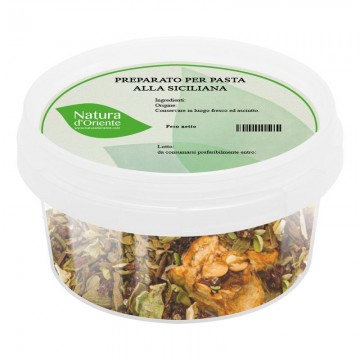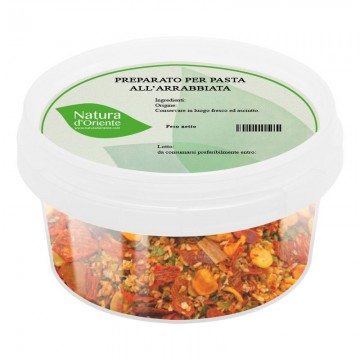Amatriciana is the most famous first course of Lazio cuisine and is probably the best known of all Italian cuisine abroad. Appreciated by anyone who loves tasty and slightly spicy dishes.
How to use our amatriciana pasta mix
For four portions, fry in a pan with enough extra virgin olive oil, two teaspoons of preparation for amatriciana, add diced bacon (or bacon for purists) and tomato and cook for a few minutes. Boil the pasta, once ready, drain and toss in the pan with the sauce obtained. Serve piping hot with a sprinkling of Parmesan or pecorino.
History of amatriciana pasta
As is well known, Amatrice is a town in the province of Rieti, therefore the amatriciana (or the Roman “matriciana”) takes its name from this town, it is also considered the place of origin, even if there are minority theses that place the birth of the amatriciana in Rome.
In reality the amatriciana is nothing more than a gricia with the addition of tomato, probably the amatriciana arrived in Lazio from Amatrice in the form of gricia and it is also possible that the happy meeting with the tomato took place in the Pontine countryside following the contacts between the shepherds of Abruzzo and the kingdom of Naples, the first hit by the crisis of the pastoralism in their region went to Rome to sell their products.
Abruzzesi? Yes it is not a mistake, today Amatrice is in Lazio, but it only became part of it in 1927 with the creation of the province of Rieti.
And what does Naples have to do with it? It should be remembered that, strange to say today, the tomato is a relatively recent addition to the Italian culinary tradition, it is a fruit that arrived in Europe only with the discovery of America and it was the Neapolitans who were among the first in Europe to recognize the merits of the tomato.
Amatrice as Abruzzo fell within the Bourbon territory and therefore the cultivation of long-grape tomatoes spread also in the Amatrician territory.
However, the first written evidence of the use of tomatoes to season pasta dates back to 1790 and is found in the kitchen manual L'Apicio Moderno, by the Roman chef Francesco Leonardi.
After all the relations between Rome and Amatrice were consolidated and in papal Rome there were many hosts and tractors originating from Amatrice, so much so that the matrician term came to mean "inn manager with kitchen". In conclusion, there is no doubt that amatriciana at least in its first white version (gricia, even if today there are other differences between the two recipes besides the use of tomato) was born in Amatrice, where the the addition of the tomato is not clear, it being understood that even if it had happened in Rome it was likely that it was the work of one of the many original hosts from Amatrice, the fact remains that the first evidence is the aforementioned manual written by a Roman cook. / p>
According to the story of the amatriciana who makes Gambero Rosso, in reality the amatriciana is not too old because the first recipe book in which it appears is that of the Roman gastronomy Ada Boni (The talisman of happiness published in 1929) and based on citations in various articles it should not be long before the First World War. So will you say Leonardi's recipe? Good question, evidently for someone that is the first recipe for pasta with tomato sauce but not by amatriciana.
Amatriciana's recipes
Yes the recipes, because in reality there are several versions of the recipe, some variations are not considered canonical and therefore in those cases according to the purists we cannot speak of true amatriciana, but others are accepted, For example, the use of pepper or chilli is not only accepted, it is considered by many to be an integral part of the original recipe, yet according to some purists if the bacon is used with all the rind which, as is known, is already peppery of its own , no more pepper or chilli should be added. However, in the version of the recipe of the Traditional Amatriciana TSG (European Union trademark which stands for Traditional Specialty Guaranteed) there are both chillies and pepper. What is absolutely not allowed is to replace the bacon with bacon, it is considered a real sacrilege.
Regarding the amatriciana recipe, however, do not have too many scruples and do it as you wish, just think that if the TSG recipe includes garlicor categorically, however, is present in the version of Ada Boni. The reason why there is unanimity on the bacon is that it is actually much better than bacon for the consistency of both lean and fat.
So for someone Boni's recipe should be the original, but for example in her recipe as well as being garlic and onion (nowadays most abandoned) the bacon is chopped and not in pieces, with all due respect to the Municipality of Amatrice, the truth is that it does not exist The recipe of the amatriciana, the one that has received the EU mark is the recipe of the traditional Amatriciana of Amatrice and is one of the many recipes of pasta all'amatriciana .
Curiosities about pasta all'amatriciana
On the net you will find a suggestive story that identifies a specific person, a certain Anna De Angelis, as the one who spread the white amatriciana in Rome, more cautiously some sites say that the diffusion it was also due to her. The woman who left Amatrice went to Rome with a haversack full of the ingredients for making pasta and near Termini station she began to cook it for the gardeners who passed by, especially those of her parts who knew that type of pasta, well it was soon discovered by the intrigued Romans.
Spaghetti or bucatini? The Romans trying to make amatriciana what they decided that bucatini are better, but in the regulations of the municipality of Amatrice we strictly speak of spaghetti, when you arrive in Amatrice the locality sign says "city of spaghetti amatriciana". According to Unione Italiana Food, an association of companies in the food sector, bucatino would win the challenge (while recognizing that spaghetti is the original shape of pasta all'amatriciana) because a strong sauce like amatriciana requires a strong shape that knows " answer "to the pillow.





 No reward points for this product.
No reward points for this product.











